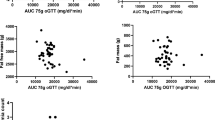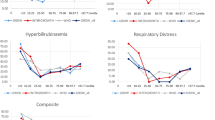Abstract
Macrosomia in neonates of diabetic women is a risk factor for neonatal hypoglycemia, with an over-risk for asymmetric macrosomia. This study aimed to study the association between anthropometric measurements and hypoglycemia in neonates of mothers treated for gestational diabetes. This is a secondary analysis of the INDAO trial study conducted between May 2012 and November 2016 in 13 French tertiary care university hospitals in 890 pregnant women with gestational diabetes treated with either insulin or glyburide. Neonatal anthropometric measurements were birthweight and weight-length ratio (WLR, defined as birth weight/length). Neonatal hypoglycemia was defined as capillary blood glucose below 36 mg/dL (2 mmol/L) or below 45 mg/dL (2.5 mmol/L) associated with clinical signs after 2 h of life. Their relationships were modeled with logistic regressions using fractional polynomials. Extreme categories of birthweight or WLR adjusted for gestational age at birth and sex were defined as Z-score < −1.28 or > 1.28. These categories were compared to Z-score between −1.28 and 1.28 by estimating odds ratios and confidence intervals for neonatal hypoglycemia. Neonatal hypoglycemia occurred in 9.1% of cases. The relationship between birthweight and WLR Z-scores and neonatal risk of hypoglycemia adjusted for maternal treatment was a U-shaped curve. Adjusted odds ratios for the risk of hypoglycemia were 9.6 (95% CI 3.5, 26.8) and 2.3 (95% CI 1.1, 4.9) for WLR Z-score below −1.28 and above 1.28, respectively, compared with WLR Z-score between −1.28 and 1.28.
Conclusion: Birthweight Z-score was associated with the risk of neonatal hypoglycemia in neonates from mothers treated for gestational diabetes. The risk of neonatal hypoglycemia was increased for both extreme birthweight Z-scores, regardless of maternal treatment. Small for gestational age neonates of diabetic mothers require special attention for the risk of neonatal hypoglycemia.
What is Known: • Macrosomia in neonates of diabetic women is a risk factor for neonatal hypoglycemia, with an over-risk for asymmetric macrosomia. Few retrospective studies have assessed the risk for neonatal hypoglycemia among small for gestational age neonates born to diabetic mothers. | |
What is New: • The risk of neonatal hypoglycemia among neonates of diabetic mothers increased for both low and high weight-length ratio, regardless of maternal medicinal treatment, gestational age at birth, and sex of the newborn. |


Similar content being viewed by others
Abbreviations
- LGA:
-
Large for gestational age
- SGA:
-
Small for gestational age
- WG:
-
Weeks of gestation
- WLR:
-
Weight/length ratio
References
Cornblath M, Hawdon JM, Williams AF et al (2000) Controversies regarding definition of neonatal hypoglycemia: suggested operational thresholds. Pediatrics 105:1141–1145. https://doi.org/10.1542/peds.105.5.1141
Vain NE, Chiarelli F, Palermo T et al (2021) Neonatal hypoglycaemia: a never-ending story? Neonatology 118:522–529. https://doi.org/10.1159/000514711
Crowther CA, Hiller JE, Moss JR et al (2005) Effect of treatment of gestational diabetes mellitus on pregnancy outcomes. N Engl J Med 352:2477–2486. https://doi.org/10.1056/NEJMoa042973
Landon MB, Spong CY, Thom E et al (2009) A multicenter, randomized trial of treatment for mild gestational diabetes. N Engl J Med 361:1339–1348. https://doi.org/10.1056/NEJMoa0902430
Holtrop PC (1993) The Frequency of hypoglycemia in full-term large and small for gestational age newborns. Am J Perinatol 10:150–154. https://doi.org/10.1055/s-2007-994649
Metzger BE, Persson B, Lowe LP et al (2010) Hyperglycemia and adverse pregnancy outcome study: neonatal glycemia. Pediatrics 126:e1545–e1552. https://doi.org/10.1542/peds.2009-2257
Bouchghoul H, Alvarez JC, Verstuyft C et al (2020) Transplacental transfer of glyburide in women with gestational diabetes and neonatal hypoglycemia risk. PLoS ONE. https://doi.org/10.1371/journal.pone.0232002
Langer O, Yogev Y, Most O, Xenakis EMJ (2005) Gestational diabetes: The consequences of not treating. Am J Obstet Gynecol 192:989–997. https://doi.org/10.1016/j.ajog.2004.11.039
Olmos PR, Borzone GR, Poblete A (2018) Gestational diabetes: glycemic control in the last two weeks before delivery contributes to newborn insulinemia. J Obstet Gynaecol Canada 40:1445–1452. https://doi.org/10.1016/j.jogc.2018.01.026
González-Quintero VH, Istwan NB, Rhea DJ et al (2007) The impact of glycemic control on neonatal outcome in singleton pregnancies complicated by gestational diabetes. Diabetes Care 30:467–470. https://doi.org/10.2337/dc06-1875
Das S, Irigoyen M, Patterson MB et al (2009) Neonatal outcomes of macrosomic births in diabetic and non-diabetic women. Arch Dis Child Fetal Neonatal Ed. https://doi.org/10.1136/adc.2008.156026
Linder N, Lahat Y, Kogan A et al (2014) Macrosomic newborns of non-diabetic mothers: anthropometric measurements and neonatal complications. Arch Dis Child Fetal Neonatal Ed. https://doi.org/10.1136/archdischild-2013-305032
Bollepalli S, Dolan LM, Miodovnik M et al (2010) Asymmetric large-for-gestational-age infants of type 1 diabetic women: morbidity and abdominal growth. Am J Perinatol 27:603–609. https://doi.org/10.1055/s-0030-1249362
Ballard JL, Rosenn B, Khoury JC, Miodovnik M (1993) Diabetic fetal macrosomia: significance of disproportionate growth. J Pediatr 122:115–119. https://doi.org/10.1016/S0022-3476(05)83503-6
Ramos GA, Hanley AA, Aguayo J et al (2012) Neonatal chemical hypoglycemia in newborns from pregnancies complicated by type 2 and gestational diabetes mellitus the importance of neonatal ponderal index. J Matern Neonatal Med 25:267–271. https://doi.org/10.3109/14767058.2011.573828
Chen LW, Tint MT, Fortier MV et al (2018) Which anthropometric measures best reflect neonatal adiposity? Int J Obes 42:501–506. https://doi.org/10.1038/ijo.2017.250
Villar J, Puglia FA, Fenton TR et al (2017) Body composition at birth and its relationship with neonatal anthropometric ratios: the newborn body composition study of the INTERGROWTH-21 st project. Pediatr Res 82:305–316. https://doi.org/10.1038/pr.2017.52
Sénat M-V, Affres H, Letourneau A et al (2018) Effect of glyburide vs subcutaneous insulin on perinatal complications among women with gestational diabetes. JAMA 319:1773. https://doi.org/10.1001/jama.2018.4072
Turner D, Monthé-Drèze C, Cherkerzian S et al (2019) Maternal obesity and cesarean section delivery: additional risk factors for neonatal hypoglycemia? J Perinatol 39:1057–1064. https://doi.org/10.1038/s41372-019-0404-z
Affres H, Senat M-V, Letourneau A et al (2020) Glyburide therapy for gestational diabetes: glycaemic control, maternal hypoglycaemia, and treatment failure. Diabetes Metab. https://doi.org/10.1016/j.diabet.2020.11.002
Villar J, Ismail LC, Victora CG et al (2014) International standards for newborn weight, length, and head circumference by gestational age and sex: the newborn cross-sectional study of the INTERGROWTH-21st project. Lancet 384:857–868. https://doi.org/10.1016/s0140-6736(14)60932-6
Royston P, Sauerbrei W (2004) A new approach to modelling interactions between treatment and continuous covariates in clinical trials by using fractional polynomials. Stat Med 23:2509–2525
Orsini N (2011) A procedure to tabulate and plot results after flexible modeling of a quantitative covariate. Stata J 11:1–29
Royston P, Sauerbrei W (2008) MFP: Multivariable Model-Building. A pragmatic approach to regression analysis on fractional polynomials for modelling continuous variables. John Wiley & Sons, Chichester
Flores-le Roux JA, Sagarra E, Benaiges D et al (2012) A prospective evaluation of neonatal hypoglycaemia in infants of women with gestational diabetes mellitus. Diabetes Res Clin Pract 97:217–222. https://doi.org/10.1016/j.diabres.2012.03.011
Kole MB, Ayala NK, Clark MA et al (2020) Factors associated with hypoglycemia among neonates born to mothers with gestational diabetes mellitus. Diabetes Care 43:e194–e195. https://doi.org/10.2337/dc20-1261
Thevarajah A, Simmons D (2019) Risk factors and outcomes for neonatal hypoglycaemia and neonatal hyperbilirubinaemia in pregnancies complicated by gestational diabetes mellitus: a single centre retrospective 3-year review. Diabet Med 36:1109–1117. https://doi.org/10.1111/dme.13962
Barquiel B, Herranz L, Martínez-Sánchez N et al (2020) Increased risk of neonatal complications or death among neonates born small for gestational age to mothers with gestational diabetes. Diabetes Res Clin Pract. https://doi.org/10.1016/j.diabres.2019.107971
Thompson-Branch A, Havranek T (2017) Neonatal hypoglycemia. Pediatr Rev 38:147–157. https://doi.org/10.1542/pir.2016-0063
Hawdon JM (2011) Babies born after diabetes in pregnancy: what are the short- and long-term risks and how can we minimise them? Best Pract Res Clin Obstet Gynaecol 25:91–104. https://doi.org/10.1016/j.bpobgyn.2010.10.005
Song R, Chen L, Chen Y et al (2017) Comparison of glyburide and insulin in the management of gestational diabetes: a meta-analysis. PLoS One 12:e0182488. https://doi.org/10.1371/journal.pone.0182488
McKinlay CJD, Alsweiler JM, Ansell JM et al (2015) Neonatal glycemia and neurodevelopmental outcomes at 2 years. N Engl J Med 373:1507–1518. https://doi.org/10.1056/NEJMoa1504909
Rasmussen AH, Wehberg S, Pørtner F et al (2020) Neurodevelopmental outcomes after moderate to severe neonatal hypoglycemia. Eur J Pediatr 179:1981–1991. https://doi.org/10.1007/s00431-020-03729-x
van Kempen AAMW, Eskes PF, Nuytemans DHGM et al (2020) Lower versus traditional treatment threshold for neonatal hypoglycemia. N Engl J Med 382:534–544. https://doi.org/10.1056/nejmoa1905593
Acknowledgements
We thank the women who participated in this study, the midwives and obstetricians involved in their care, and David Marsh for his help in editing this manuscript.
Funding
This study was funded by a research grant from the French Ministry of Health and was sponsored by Paris Public Hospitals (AP-HP, Assistance Publique-Hôpitaux de Paris), via its Clinical Research Department.
Author information
Authors and Affiliations
Contributions
H. Bouchghoul and D. Mitanchez conceptualized and designed the study, carried out the initial analyses, drafted the initial manuscript, and reviewed and revised the manuscript. A. Letourneau collected data and reviewed and revised the manuscript. J. Bouyer and M-V. Senat conceptualized and designed the study, coordinated and supervised data collection, and critically reviewed the manuscript for important intellectual content. All authors approved the final manuscript as submitted and agree to be accountable for all aspects of the work.
Corresponding author
Ethics declarations
Ethics approval
The INDAO trial protocol, including this ancillary study for which patients provided additional informed consent, was approved by the ethics committee of the Poissy St-Germain Hospital (France) and registered in clinicaltrials.gov (NCT01731431). Data were collected by research staff members from medical records including medical history and outcome data.
Competing interests
The authors declare no competing interests.
Additional information
Communicated by Daniele De Luca
Publisher's Note
Springer Nature remains neutral with regard to jurisdictional claims in published maps and institutional affiliations.
Rights and permissions
About this article
Cite this article
Bouchghoul, H., Mokhtari, D.M., Letourneau, A. et al. Risk of hypoglycemia by anthropometric measurements in neonates of mothers with diabetes. Eur J Pediatr 181, 3483–3490 (2022). https://doi.org/10.1007/s00431-022-04532-6
Received:
Accepted:
Published:
Issue Date:
DOI: https://doi.org/10.1007/s00431-022-04532-6




